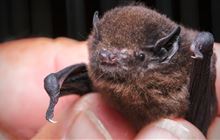26-year-old bat could be New Zealand’s oldest
Introduction
New Zealand’s oldest known long-tailed bat/pekapeka – at 26 years – was recorded this summer as part of a DOC monitoring programme in Fiordland.Date: 04 March 2024
Known only as ‘T7787’, the tiny flying mammal was caught in a harp trap last month, given a quick health check, then released to rejoin her colony at Walker Creek in the Eglinton valley, where she’s lived her entire life.
DOC Principal Scientist Colin O’Donnell, who leads the bat monitoring work, says T7787 is officially the oldest known long-tailed bat in Aotearoa New Zealand.
“I first caught her when she was a young mother in 2000 and again this month, making her at least 26 years old but possibly as old as 28.”
“She’s going a little grey but still appears in good health, although signs are she’s stopped breeding.
“We don’t know how long our bats live for so it’s exciting to get this record and know they can live for up to 26 years if conditions are right.”
T7787, who weighs just 10.5g (about the same as a AAA battery), has produced a pup every year for 20 years. With female bats able to breed from two years old, she will now be the matriarch of many bat generations.
Long-tailed bats are threatened with extinction, having declined dramatically since pre-human times because of habitat loss and predation by introduced pests.
Colin O’Donnell says the bat’s long breeding life bodes well for its recovery and potential to increase towards pre-human population levels when bats were abundant.
In the Eglinton valley, long-term monitoring of both long-tailed and short-tailed bats has shown a steady increase in bat numbers in response to large-scale predator control using trapping, bait stations and aerial 1080 to target rats, stoats and possums.
Prior to 2000, the long-tailed bat population was declining by 5% per year but that has been reversed and is now growing by 5% showing the benefits of DOC’s multi-pronged predator management.
Bat monitoring is labour-intensive with teams of volunteers working alongside DOC experts over six weeks each summer. It involves finding bat roosts in cavities high up in trees and setting up harp traps during the day near where bats will leave the roost in the evening. The team then returns at night to process the captured bats – measuring and weighing them and recording their tags before releasing them.
While most bats never leave their colony, they do shift roosts most nights, presenting a daily challenge for the monitoring team to find the new roosts.
The previous oldest long-tailed bat, recorded and last seen in 2015, was another female, A78806, in the Walker colony who was 25.
Most of the 1400 bat species around the world live between six and 20 years on average, although a small number are known to live more than 30 years. For their small body size, bats are relatively long-lived mammals, which is of interest to scientists.
Background information
Long-tailed bats are distributed throughout New Zealand and have the highest threat ranking of ‘Nationally Critical’.
They prefer native forest, but some survive in plantation forests, bush fragments and around urban areas like Hamilton and Auckland. They are sometimes seen flying at dusk along forest edges, or over streams and farmland on their way out to feed on small insects.
Contact
For media enquiries contact:
Email: media@doc.govt.nz

